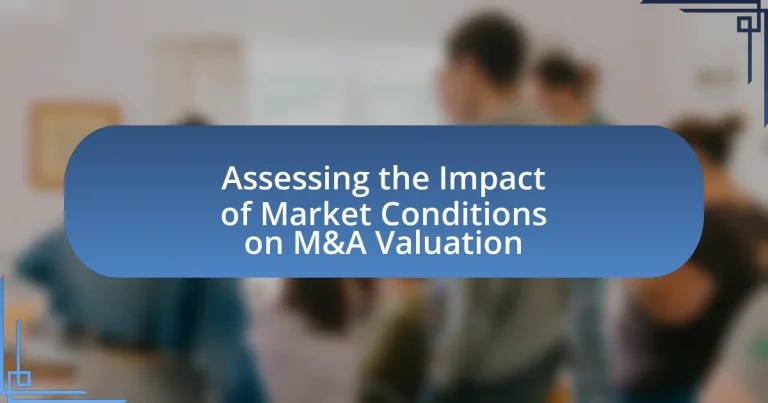The article focuses on assessing the impact of market conditions on mergers and acquisitions (M&A) valuation. It outlines how favorable and adverse market conditions influence valuations, deal activity, and investor sentiment, highlighting key factors such as economic growth rates, interest rates, and market liquidity. The discussion includes historical examples, particularly the effects of the 2008 financial crisis, and emphasizes the importance of understanding market dynamics for effective M&A strategies. Additionally, it provides practical steps for evaluating M&A valuations in current market conditions, including market analysis and risk assessment.

What is the Impact of Market Conditions on M&A Valuation?
Market conditions significantly influence M&A valuation by affecting the perceived risk and potential return of transactions. In favorable market conditions, characterized by economic growth and high investor confidence, companies often command higher valuations due to increased competition for assets and optimistic future earnings projections. Conversely, during economic downturns or periods of uncertainty, valuations typically decline as buyers become more cautious, leading to lower offer prices and increased scrutiny of financial performance. Historical data from the 2008 financial crisis illustrates this impact, where M&A activity dropped sharply, and valuations decreased as companies faced tighter credit conditions and reduced consumer demand.
How do market conditions influence M&A activity?
Market conditions significantly influence M&A activity by affecting the availability of capital, valuations, and strategic motivations for mergers and acquisitions. In favorable market conditions, characterized by strong economic growth and high stock prices, companies are more likely to pursue M&A as they have greater access to financing and are willing to pay premium valuations. For instance, during the economic expansion from 2010 to 2019, global M&A activity reached record levels, with deal values exceeding $4 trillion in 2018, driven by robust market confidence and liquidity. Conversely, in adverse market conditions, such as economic downturns or financial crises, M&A activity typically declines due to reduced access to capital, lower valuations, and heightened uncertainty. The 2008 financial crisis serves as a clear example, where global M&A activity plummeted to approximately $2 trillion, reflecting the negative impact of market instability on corporate acquisition strategies.
What specific market conditions are most impactful on M&A valuations?
Market conditions that significantly impact M&A valuations include economic growth rates, interest rates, and market liquidity. Economic growth rates influence corporate earnings potential, with higher growth typically leading to increased valuations. Interest rates affect the cost of capital; lower rates generally enhance valuations by making financing cheaper. Market liquidity, which refers to the ease of buying and selling assets, also plays a crucial role; higher liquidity can lead to more competitive bidding and higher valuations. Historical data shows that during periods of economic expansion, such as the post-2008 recovery, M&A activity surged, resulting in higher valuations, while periods of economic downturn, like the 2001 recession, saw valuations decline sharply.
How do economic cycles affect M&A valuations?
Economic cycles significantly influence M&A valuations by altering the perceived risk and growth potential of target companies. During economic expansions, higher consumer spending and business investment typically lead to increased valuations due to optimistic growth forecasts and greater access to financing. For instance, according to a report by PwC, M&A activity often peaks during economic upturns, with valuations rising as companies compete for attractive targets. Conversely, during economic downturns, valuations tend to decline as uncertainty increases, leading to more conservative estimates of future cash flows and heightened risk aversion among buyers. Historical data from the Institute for Mergers, Acquisitions and Alliances indicates that M&A deal volume and valuations drop significantly during recessions, reflecting the negative impact of economic cycles on market confidence and investment appetite.
Why is understanding market conditions crucial for M&A valuation?
Understanding market conditions is crucial for M&A valuation because they directly influence the perceived value of a target company and the terms of the deal. Market conditions, such as economic trends, industry performance, and competitive landscape, affect buyer and seller expectations, which in turn shape valuation multiples and negotiation dynamics. For instance, during a market downturn, companies may be valued at lower multiples due to reduced earnings potential, while a booming market can inflate valuations. Historical data shows that M&A transactions completed during favorable market conditions often yield higher returns for acquirers, emphasizing the importance of aligning valuation strategies with current market realities.
What role do investor sentiment and market trends play in M&A valuations?
Investor sentiment and market trends significantly influence M&A valuations by affecting perceived value and negotiation dynamics. Positive investor sentiment often leads to higher valuations as buyers are more willing to pay a premium for acquisitions, driven by optimism about future growth and profitability. Conversely, negative sentiment can depress valuations, as seen during economic downturns when buyers become more risk-averse and valuations decline. For instance, during the 2008 financial crisis, M&A activity dropped sharply, with valuations reflecting the prevailing market pessimism. This correlation between market trends and investor sentiment underscores their critical role in shaping M&A outcomes.
How can market volatility affect the perceived value of a merger or acquisition?
Market volatility can significantly decrease the perceived value of a merger or acquisition by creating uncertainty around future cash flows and operational stability. When market conditions are unstable, investors often reassess the risk associated with the transaction, leading to a higher discount rate applied to projected earnings. For instance, during periods of high volatility, such as the 2008 financial crisis, many M&A deals were either delayed or valued lower due to heightened risk perceptions and fluctuating stock prices. This correlation between volatility and valuation is supported by research indicating that increased market fluctuations lead to more conservative valuations, as seen in studies analyzing M&A activity during turbulent economic periods.

What are the Key Market Conditions Affecting M&A Valuation?
Key market conditions affecting M&A valuation include economic climate, interest rates, industry trends, and regulatory environment. The economic climate influences buyer and seller confidence, impacting deal activity and pricing; for instance, during economic downturns, valuations typically decrease due to heightened risk perception. Interest rates affect the cost of financing, where lower rates can lead to higher valuations as borrowing becomes cheaper. Industry trends, such as technological advancements or shifts in consumer behavior, can create opportunities or risks that alter valuations. Lastly, the regulatory environment, including antitrust laws and foreign investment restrictions, can significantly impact the feasibility and attractiveness of M&A transactions, as seen in recent high-profile cases where regulatory scrutiny has led to deal cancellations or adjustments.
How do interest rates impact M&A valuations?
Interest rates significantly impact M&A valuations by influencing the cost of capital and the discount rates applied to future cash flows. When interest rates rise, the cost of borrowing increases, leading acquirers to demand higher returns on investments, which can lower the valuations of target companies. Conversely, lower interest rates reduce borrowing costs, allowing acquirers to justify higher valuations due to lower discount rates applied to projected cash flows. For instance, a study by the Federal Reserve Bank of New York found that a 1% increase in interest rates can decrease M&A deal values by approximately 10%, illustrating the direct correlation between interest rates and M&A valuations.
What is the relationship between interest rates and deal financing?
Interest rates directly influence deal financing by affecting the cost of borrowing. When interest rates are low, financing costs decrease, making it easier for companies to secure loans for mergers and acquisitions, which can lead to an increase in deal activity. Conversely, high interest rates raise borrowing costs, potentially dampening deal financing as companies may be less willing to take on expensive debt. Historical data shows that during periods of low interest rates, such as the post-2008 financial crisis, M&A activity surged, highlighting the correlation between favorable financing conditions and increased deal-making.
How do changes in interest rates influence buyer and seller expectations?
Changes in interest rates significantly influence buyer and seller expectations by altering the cost of financing and the perceived value of investments. When interest rates rise, borrowing costs increase, leading buyers to expect lower valuations for acquisitions due to higher capital costs. Conversely, sellers may anticipate reduced demand for their assets, as potential buyers may be deterred by increased financing expenses. Historical data shows that during periods of rising interest rates, such as the Federal Reserve’s actions in the late 1970s, M&A activity often declines as both parties adjust their expectations to align with the new economic environment. This dynamic illustrates how interest rate fluctuations directly impact the negotiation landscape in mergers and acquisitions.
What role does market liquidity play in M&A valuations?
Market liquidity significantly influences M&A valuations by affecting the ease with which assets can be bought or sold without impacting their price. High market liquidity typically leads to higher valuations, as it allows for quicker transactions and reduces the risk premium that buyers demand. For instance, during periods of high liquidity, such as the 2010-2019 bull market, M&A activity surged, with valuations often exceeding historical averages due to favorable financing conditions and investor confidence. Conversely, low liquidity can depress valuations, as seen during the 2008 financial crisis, where M&A deals were scarce and valuations dropped due to heightened uncertainty and risk aversion. Thus, market liquidity serves as a critical determinant in establishing the price and feasibility of M&A transactions.
How does liquidity affect the availability of capital for M&A transactions?
Liquidity directly influences the availability of capital for M&A transactions by determining how easily assets can be converted into cash. High liquidity in financial markets allows companies to access capital more readily, as investors and lenders are more willing to provide funding when they perceive lower risk and higher market activity. For instance, during periods of high liquidity, such as the post-2008 financial crisis recovery, M&A activity surged, with global deal values reaching approximately $4 trillion in 2015, as companies capitalized on favorable financing conditions. Conversely, low liquidity constrains capital availability, leading to reduced M&A activity, as seen during economic downturns when credit markets tighten and investors become risk-averse.
What are the implications of low liquidity on M&A deal structures?
Low liquidity significantly impacts M&A deal structures by increasing the cost of capital and limiting the availability of financing options. When liquidity is low, acquirers may face higher risk premiums, leading to more conservative valuations and potentially lower offer prices. Additionally, low liquidity can result in longer negotiation periods and increased reliance on cash transactions, as sellers may be less willing to accept stock as part of the deal. Historical data from the 2008 financial crisis illustrates this, where M&A activity declined sharply due to liquidity constraints, forcing companies to adjust their deal structures to accommodate cash-heavy transactions and lower valuations.

How Can Companies Navigate Market Conditions for Better M&A Valuation?
Companies can navigate market conditions for better M&A valuation by conducting thorough market analysis and adjusting their strategies accordingly. By analyzing current economic indicators, industry trends, and competitor performance, companies can identify optimal timing for transactions and negotiate better terms. For instance, during economic downturns, companies may find undervalued targets, while in booming markets, they can leverage higher valuations. Historical data shows that companies that align their M&A strategies with market cycles tend to achieve 20-30% higher returns on investment compared to those that do not.
What strategies can companies employ to assess market conditions effectively?
Companies can employ several strategies to assess market conditions effectively, including conducting market research, analyzing economic indicators, and utilizing competitive analysis. Market research involves gathering data on consumer preferences and trends, which helps companies understand demand dynamics. Analyzing economic indicators, such as GDP growth rates and unemployment figures, provides insights into the overall economic environment that influences market conditions. Competitive analysis allows companies to evaluate their competitors’ performance and strategies, offering a clearer picture of market positioning. These strategies are validated by the fact that organizations that leverage data-driven insights are 5 to 6 times more likely to make informed decisions, as reported by McKinsey & Company.
How can companies leverage market analysis in their M&A strategy?
Companies can leverage market analysis in their M&A strategy by identifying trends, assessing competitive landscapes, and evaluating potential synergies. By conducting thorough market analysis, companies can uncover valuable insights into industry dynamics, customer preferences, and economic conditions that influence valuation. For instance, a study by PwC found that 53% of executives believe that understanding market trends is crucial for successful M&A transactions. This data underscores the importance of market analysis in making informed decisions that enhance the likelihood of achieving strategic objectives and maximizing shareholder value during mergers and acquisitions.
What tools and resources are available for evaluating market conditions?
Tools and resources available for evaluating market conditions include financial databases, market research reports, and economic indicators. Financial databases such as Bloomberg and Reuters provide real-time data on stock prices, trading volumes, and financial metrics, which are essential for assessing market trends. Market research reports from firms like Gartner and McKinsey offer insights into industry performance and consumer behavior, helping analysts understand market dynamics. Economic indicators, including GDP growth rates, unemployment rates, and inflation data, serve as critical benchmarks for evaluating overall economic health and market conditions. These resources collectively enable stakeholders to make informed decisions regarding mergers and acquisitions by providing a comprehensive view of the market landscape.
What best practices should companies follow during M&A in varying market conditions?
Companies should conduct thorough due diligence and maintain clear communication during M&A in varying market conditions. Thorough due diligence ensures that companies understand the financial health, operational capabilities, and market position of the target, which is crucial in fluctuating markets where valuations can be volatile. Clear communication among stakeholders, including employees, investors, and customers, helps manage expectations and reduces uncertainty, which is particularly important in unstable economic environments.
Additionally, companies should adopt flexible deal structures that can accommodate changes in market conditions, such as earn-outs or contingent payments, which allow for adjustments based on future performance. Historical data shows that firms employing these practices are better positioned to navigate the complexities of M&A transactions, as evidenced by a study from PwC indicating that 70% of successful M&A deals involved proactive risk management strategies tailored to market conditions.
How can companies prepare for potential market downturns during M&A?
Companies can prepare for potential market downturns during M&A by conducting thorough due diligence and stress testing financial models. This approach allows firms to identify vulnerabilities in target companies and assess how economic fluctuations could impact valuations. For instance, a study by PwC highlights that companies that incorporate scenario analysis into their M&A strategy can better anticipate risks and adjust their offers accordingly, leading to more resilient deal structures. Additionally, maintaining a flexible deal structure, such as including earn-outs or contingent payments, can help mitigate risks associated with market volatility.
What are the common pitfalls to avoid in M&A valuation during volatile markets?
Common pitfalls to avoid in M&A valuation during volatile markets include over-reliance on historical data, neglecting market sentiment, and failing to adjust for risk premiums. Over-reliance on historical data can lead to inaccurate projections, as past performance may not reflect current market conditions. Neglecting market sentiment can result in undervaluing or overvaluing a target, as investor perceptions can significantly influence valuations during volatility. Additionally, failing to adjust for risk premiums can lead to an underestimation of the required return on investment, which is crucial in uncertain environments. These pitfalls can distort the valuation process and lead to poor decision-making in M&A transactions.
What are the practical steps for assessing M&A valuation in current market conditions?
To assess M&A valuation in current market conditions, analysts should follow these practical steps: first, conduct a thorough market analysis to understand prevailing economic indicators, such as interest rates, inflation, and industry trends. This analysis provides context for valuation adjustments. Second, utilize multiple valuation methods, including discounted cash flow (DCF), comparable company analysis, and precedent transactions, to triangulate a fair value range. Third, adjust projections based on current market conditions, incorporating realistic growth rates and risk factors that reflect the economic environment. Fourth, assess the strategic fit and synergies of the target company, as these can significantly influence valuation. Finally, consider external factors such as regulatory changes and geopolitical risks that may impact the deal’s feasibility and valuation. These steps ensure a comprehensive approach to M&A valuation that aligns with current market realities.


